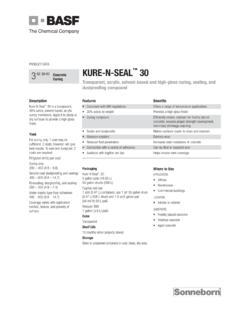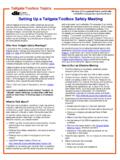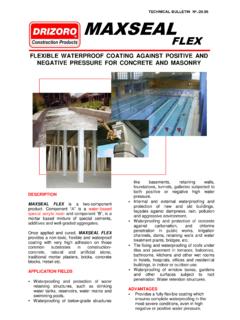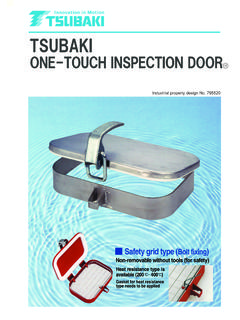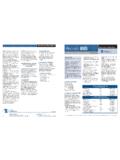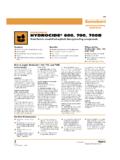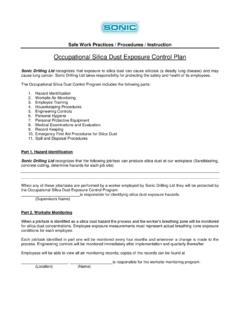Transcription of GOOD MASONRY PRACTICES INSTALLING …
1 MANUFACTURERS OF CONCRETE MASONRY (315) 437-0305 Phone 5894 Court Street Road (315) 463-9134 Fax Syracuse, New York 13206-0280 November 21, 2016 GOOD MASONRY PRACTICES INSTALLING CUSTOM CONCRETE BLOCK MINIMIZE STAINING Avoid excessive condensation in stretch wrapped block. Significant moisture can develop in cubes of stretch wrapped block in a relatively short period of time. Once the block become visibly wet from the trapped moisture, they will remain wet until the plastic is removed. This wet, unbreathable condition will often cause efflorescence. Minimize the time block are stored in stretch wrapped plastic. If condensation occurs, remove the wrap and protect block with a tarp. When using Custom Concrete Block, be careful not to stain the exposed surface of the block with mortar or grout.
2 The additional time it takes to keep the exposed surface clean, is an investment compared to the time it takes to clean the MASONRY later. Severe stains can not be cleaned without damaging the MASONRY appearance. Wet cutting concrete block often leaves a white stain, which is the residual of the cement and aggregate. This cement slurry is very difficult to remove once it has dried and hardened. If you wet cut, thoroughly wash the cut unit immediately after removal from the saw. If you dry cut, it is equally critical to blow dust off the block. If this dust becomes wet, you again have cement slurry that when dry will be extremely hard to remove without damaging the MASONRY appearance. Please be aware that most MASONRY products contain respirable crystalline quartz. Failure to follow an appropriate protection plan when sawing, grinding or blowing off dust, could be harmful to your health.
3 OSHA has a Special Silica Protection Plan that outlines the minimum steps that should be taken. Information can be found on their website @ Cover the top of unfinished MASONRY work to protect it from the weather. Efflorescence will usually result when tops of walls are left open to moisture penetration. Mortar joints for exterior MASONRY should be concave tooled. Raked, cut or brushed joints are poor weathering joints and invite water penetration and efflorescence. If possible, avoid double stacking cubes of custom concrete block, when stocking the jobsite . Double stacking will result in greater jobsite chipping and creates the possibility of wood sap leeching out of the wooden pallet and staining the block below. The stain from wood sap is extremely difficult to remove from MASONRY . RainBloc RainBloc Mortar Admix directions should be followed closely to assure a properly functioning wall system.
4 ASTM C-270 PROPORTION SPECIFICATION BASED ON 1 BAG ====1 CUBIC FOOT COMMON MIX DESIGNS Hydrated RainBloc Mason Mortar Type Portland Lime Mortar Admix Sand Portland Cement M 1 Bag Bag 32 quart bottle Not Less Than and Lime S 1 Bag Bag 32 quart bottle 2 and not N 1 Bag 1 Bag 32 quart bottle more than 3 _____ times the sum of MASONRY Cement M 1 Bag 16 quart bottle the separate volumes Or S 1 Bag 16 quart bottle of cementitious Mortar Cement N 1 Bag 16 quart bottle materials Never use RainBloc Mortar Admix if it has frozen. When an accelerator is allowed by specifications, we recommend that only Intermix by ACM Chemistries be used with RainBloc Mortar Admix.
5 (also produced by ACM Chemistries) Otherwise, approval for chemical compatibility between RainBloc Mortar Admix and a different chemical accelerator, should be made through the architect's office. If you are using a prepackaged mortar mix such as Spec Mix, make certain no additives are blended into the Spec Mix, without the approval of the Architect. For example, compatibility would be a serious concern if the Spec Mix contained an integral water-repellent and RainBloc Mortar Admix was added into the Spec Mix at the mixer. COLOR CONSISTENCY When using Barnes & Cone's Custom Mortar Color Batches, closely follow the directions printed onto every bag. Never use a portion of a bag (batch) for a reduced volume mix. Most batches contain three or four pigments. Once the batch is blended together in our lab, you can not successfully divide it into smaller, partial batch.
6 To achieve consistent color, carefully measure the water and sand put into the mixer. Use the same volume batch to batch. Mason Sand should be protected on site to assure uniform water content. The relatively small inventories of sand found on a jobsite can become saturated with rain, resulting in significantly more water added to the mix through the sand. Mixing time has a significant effect on the final color of the mortar. Materials should be added into the mixer in the same sequence batch to batch. Pigments should be mixed at a constant, specific time batch to batch. After all materials are in the mixer, they should be mixed for 3 to 5 minutes. However, once you determine the most effective mix time (within the 3 to 5 minutes) keep it the same batch to batch. Varying the mixing time of colored mortars, will develop the pigment inconsistently and create different colors.
7 Even when everything else is the same! Protect uncured mortar joints from rain or snow. Moisture striking an uncured mortar joint will turn the joint into a milky white color. Tool mortar joints consistently, once the mortar has dried to a "thumb print hard" consistency (when a clear thumbprint can be impressed and the cement paste does not adhere to the thumb.) A mortar joint tooled wet, will yield a brighter or lighter color. If the mortar becomes too stiff (dry) a darker joint will result. If the same mortar out of the same batch is tooled at all three levels of moisture .. wet, thumb print hard and dry ..three different and distinct colors will result. Cleaning Architectural Concrete MASONRY Units Keeping MASONRY Clean During Construction, Will Yield The Best Results, In The Least Time, For The Lowest Cost! Keep in mind that mortar stains will achieve strengths comparable to concrete slabs in 7 to 28 days.
8 Cleaning MASONRY within 4 to 7 days from construction will minimize the need for aggressive cleaning methods to remove stains. Allowing MASONRY to remain uncleaned for extended periods of time increases the chances that stain removal will damage to walls. Cleaning MASONRY soon after construction will assist in making the cleaning process effective. Cleaning of MASONRY is an action that requires the mason contractor to determine the optimal Means and Methods to achieve the desired results. Cleaning methods should be demonstrated as safe and effective before proceeding to clean the completed work. The most effective way to demonstrate a safe and effective cleaning method is to perform that method on a sample panel, and receive approval from the designer and owner prior to cleaning the entire building with the approved method. For a good overview of cleaning requirements- Please see the Concrete Products Design Note Video: Cleaning with water and a stiff brush is the safest method to assure that the cleaning process will not damage the MASONRY .
9 Many times cleaning with water and a stiff brush is effective when the walls have been kept reasonably clean. In addition to cleaning with water and a stiff brush we have seen positive results using the cleaning procedures listed below. Each procedure is described briefly, followed by a list of the different types of Architectural CMU and the cleaning procedures that we have seen work successfully. These descriptions are meant only as an overview as the entire process is not described in this document. For full descriptions of the specific processes we recommend completely reading and understanding the manufacturer s literature when using chemicals and the tool manufacturer s literature for pressure washing, abrasive blasting and diamond polishing. These cleaning procedures should only performed by an experienced mason contractor well versed in cleaning concrete MASONRY .
10 Misapplication can result in permanent damage to the MASONRY . Pressure Wash: If specifications allow pressure washing, limit the size of the machine to 2,000 PSI. Use a wide flange tip. Never use a pointed tip. Keep the tip a minimum of 12" from the MASONRY surface. Direct the spray at a 45 angle onto the wall. Using a pointed tip or spraying closer than 12" away from the wall or spraying directly (perpendicular) at the wall, can remove cement paste from the MASONRY surface. The typical result is a series of swirling dark lines, mirroring the path the operator followed with the pressure wash wand. This can be a permanent condition! Pressure washing can introduce a tremendous volume of water into the wall system. It is important that any water entering the wall system does not become trapped and that it is quickly removed through the flashing/weep system and evaporation.
